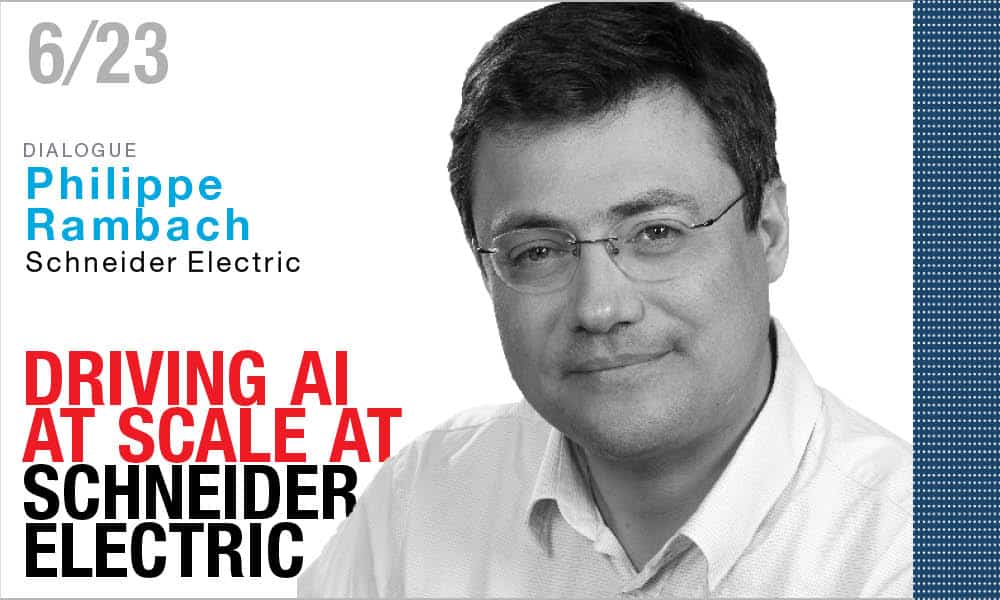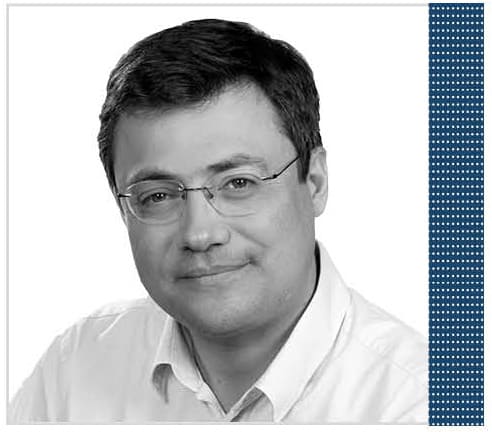Dialogue: Driving AI at Scale at Schneider Electric

Without AI, the manufacturing industry will never be able to achieve the levels of efficiency, insights, and sustainability it needs for the future, believes Schneider Electric’s Chief AI Officer, Philippe Rambach.

“AI is going to be pervasive. It will be everywhere. It’s transforming our company and it’s transforming the way our customers operate. I believe AI will have an impact on everything over the next few years.”
Philippe Rambach Chief AI Officer, Schneider Electric
In 1836, brothers Adolphe and Joseph-Eugene Schneider took over an iron foundry in Le Creusot, in the Bourgogne region of France. Two years later, they founded Schneider-Creusot, the company that would eventually become Schneider Electric.
Now a $37 billion global enterprise, today Schneider Electric focuses on digital automation and electrification systems, supported by a network of over 160 manufacturing sites, and more than 135,000 employees worldwide.
In 2021, Schneider appointed its first ever Chief AI Officer, Phlippe Rambach, who now runs a dedicated AI team of 250 AI experts and data scientists focused on global hubs in Paris and Grenoble, France, Bangalore in India, and Boston in the U.S.
In our latest interview with an industry thought-leader, Schneider’s CAIO Philippe Rambach talks to the MLC’s Executive Editor Paul Tate about the company’s strategic goal of developing AI at Scale, how the power of AI can unleash massive operational improvements in industrial efficiency, and why he believes the world will never be able to manage the energy transition it needs to meet global climate goals without AI to help make it happen.

“We always start from the use case with the goal of delivering real business value. What do our businesses need to do, and out of everything they have to do, where can AI help?”
Q: What’s your role at Schneider Electric?
A: I’m the first ever Chief AI Officer of Schneider Electric, and I’m sure I won’t be the last one. My role is to make sure that we leverage AI as much as we can, first for everything related with internal efficiency, customer satisfaction, and all our internal goals. But also, that we leverage AI to help our customers reach their goals to be more sustainable and more efficient by helping them to digitize and electrify. In every aspect, AI is a key component to making that happen.
Q: What excites you most about that role?
A: There are a few things. First, as a planet, we face the dilemma of industrial sustainability, of dealing with climate change. I am amazed how much AI can contribute to solve that. At Schneider, we’ve been working on sustainability for many years, but now AI is significantly accelerating that effort. AI’s potential to help solve some of the most important global problems makes me really excited. It’s like, “Wow! We now have a great tool that we can leverage to do a lot of great things.”
The second is around transformation. AI is going to be pervasive. It will be everywhere. It’s transforming our company and it’s transforming the way our customers operate. It’s a way to touch everything in our own company and everything in our customers’ businesses. I believe AI will have an impact on everything over the next few years. That excites me.
The third is more personal. My background is in deep mathematics and science. After 15 years in a company, you start to do a lot more on the business side, and you think, “Okay, maybe technical jobs are gone forever.” But this job is one of the few where you have both a technical dimension, because to do AI at scale you need to understand what it is and go beyond the smoke and mirrors, but at the same time you need a very strong business understanding. That’s exciting because there are not that many jobs where you have a really strong conjunction of technical and business ideas.
Finally, recent developments over the last five years in technologies like large language models (LLMs) have rapidly become techniques that everybody is using. There are very few domains in engineering where you go that fast from hardcore scientific research into a full speed use. And that’s amazing.
Q: What’s driving Schneider’s overall AI strategy today?
A: Our strategy is what we call “AI at Scale”. That’s what’s driving all of this. That means we always start from the use case with the goal of delivering real business value. We never say, “Oh, there is a new tech, like OpenAI or ChatGPT, what could we do with that?” We always start from what do our businesses need to do, and out of everything they have to do, where can AI help?
I still see many companies who start from the technology, do a couple of pilots of what they can do with it, and then try to sell it internally. We have taken a reverse approach where we start with the business, sit with them with an internal AI consultant, understand their challenges and their goals, and then identify where AI can help.
Then we select our use cases clearly around the business value. That’s not always measured in terms of euros or dollars. It can also be carbon emissions, or customer satisfaction, whatever the business value is. We have many more use cases than we can deliver, of course, so we focus on the largest use cases with the largest impact. And then, to make sure we can do that successfully at scale, we create a joint squad where we merge people from our AI hub with people from the lines of business or key functions.
So, we deploy at scale. Never think pilot. Always think, “What do I want to deliver at scale, and how do I get there?”

“Business value is not always measured in terms of euros or dollars. It can also be carbon emissions, or customer satisfaction, whatever the business value is.”
That’s a very different approach than many companies have taken with what they call the Digital Factory, where they are in a kind of a customer/supplier relationship where the business says, “I want that,” and the digital factory does it. The AI hub is not organized that way in Schneider. We really work on a hub and spoke model where we identify the use case together – the AI hub brings all the AI knowledge, but the line of business brings the domain knowledge and everything else. In the end, the business value, the business deployment, and the ownership, stays with the business.
Q: How is the AI function currently structured within Schneider?
A: There’s now a team of around 250 AI experts and data scientists in Schneider, and we’ll be at around 300 by the end of the year. Those experts are focused around three main locations – Paris and Grenoble in France, Boston in the U.S., and Bangalore in India. These were chosen because we wanted to be where we had access to the right pool of talent, such as universities and so on, where Schneider is strong geographically and would be attractive to data scientists seeking a career where they can be involved in many different things, and where we have strong domain knowledge so they can work closely together with our business teams.
We also made the decision, very early when we first started, to have somebody in charge of “Responsible AI”, a digital risk leader, or a data officer. If you start an AI initiative, and then after six months you have big crisis of ethics, of responsibility, you can kill all your efforts. That’s one recommendation I would make to other companies; start with this kind of function to make sure that what you do is responsible and is ethical for the future.
Q: What approach do you take to developing new AI solutions?
A: During the process of development, we do pilots to check if it all works, of course, but when we develop things, we know we always want to have this at scale from the very beginning, so we are always asking what do we need to do to reach that? It’s probably more difficult to implement this way, but it gives us a much better chance of making an impact and ensuring solutions are used at scale. So far, it is working pretty well.
We also have traditional gate review process. We do ideation, exploration, incubation, all of that. But at each gate review we check two things. We check, from a technical point of view, if we can solve the issue. Do we have enough data? Is the algorithm good enough? But we also check if we still have the business value. We have stopped projects for both reasons, either because technically we couldn’t deliver, or because the business members of the squad were saying, “Yeah, the idea initially looked super nice, it works well, but finally we don’t really know how to use it and bring it in at scale.”
One outcome we didn’t really plan for, but that also works very well, is that we began to realize that by approaching development this way, we never actually develop new stand-alone AI products. We always develop features in existing products because people do not want yet another tool. What they want is the tool that they are using today to manage their solution, their software, or whatever it is, and we create AI features within that tool, almost trying to have people forget it’s AI. That’s another important way of developing effective AI solutions that can be easily adopted at scale.

“AI is another tool to help people achieve set goals, and that will mean change. So, the first question is, are you used to change?”
Q: What AI use cases would you highlight in Schneider so far?
A: Like a lot of companies, we use ERP systems in our factories containing thousands of supply chain parameters, minimum order quantity, lead time, etc., which you may update quarterly, or if you’re a little lazy, yearly, or sometimes never because it’s such a big effort. We have developed the concept of self-healing supply chain using AI to automatically and continuously update those critical parameters to update the overall supply chain. When you manage over 150 factories, thousands and thousands of suppliers, hundreds of thousands of ordering lines, delivery lines, references, and all of that, without AI it’s almost impossible to do. It’s too complicated. That’s brought us lots and lots of efficiency.
It’s the same logic in the production facilities themselves. Very often you buy a machine or set up a process and you set your parameters during your first tests. But then, until there is a big drift, you don’t review those parameters at all. But things do drift. Things do change. With AI we have implemented a system that, at the automation level, for example, continuously updates the parameters of the production line to ensure better yield, better quality.
In sustainability, AI can also make a huge difference. One of the big impacts of moving to a more electrified, decarbonated world is the growth of what we call “prosumers” – companies that not only use, but also produce electricity, like a large factory that has solar panels and maybe wind generation or other systems to ensure power reliability. We have developed a solution to automate the choice to decarbonate that energy usage by helping companies forecast the need for energy in the next few hours, or days, and then decide between using the power it generates directly to run the factory, store it in a battery for later usage, or even sell it to the grid. By deploying such solutions in our buildings, for example, our headquarters in Grenoble is now carbon net zero. So, AI has had a big impact on sustainability.
Those are just some examples of how AI can really help manufacturing companies become more efficient, sustainable, and resilient. There are many more.
Q: Once you’ve developed these new AI systems, how do you then operationalize the data and insights they produce to drive real improvements across the company?
A: It’s a very good question. First, we decided at an early stage to put a lot of investment in building a strong AI platform to create trust among our people that data will not leak and that we will monitor model and data drift and all of that. So that’s one thing.
But the biggest part is more about cultural change and acceptance. The first thing you need to look at is what your company is doing and how it is operating. AI is another tool to help people achieve set goals, and that will mean change. So, the first question is, are you used to change?

“I think globally, as an industry, we need to make sure that everybody in our companies has an understanding of what AI means.”
We are lucky at Schneider that our production sites and factories already have a very strong culture of lean and change management. If you are in a company with no culture of lean, maybe it’s better to implement lean before implementing AI. It is also lucky that Schneider already had a strong data culture with data lakes, data governance, a data organization, and we had extensive digitization. AI needs data and it comes at a certain point in a digitization journey. If you’ve done zero digitization, maybe you should better start with some digitization first.
So, in Schneider, we already had a good culture of change management, data management, and digital progress. However, in addition to that, I am a strong believer that we need, and we have still work to do on this, everybody in a company to understand something about AI. Starting from the worker, right up to the CEO. They don’t need to understand the same things, of course, but they need to have some level of understanding, adequate for their job. So, some will go on a six-month training course if they are doing in-depth data development. But some will just need a two-hour explanation.
In my younger days I was in charge of Six Sigma deployment, and I think we need to get back to that kind of initiative with AI, with levels like green belts, or black belts, and overall training of the basic concepts.
We are now trying to find the best ways to address everybody in our company, so we have segmented the Schneider population into five main groups and use change management processes, communication, and other targeted ways to engage and educate those groups. Some of them go to hardcore training at a digital and data academy, while some are invited to monthly talks about AI. We still have work to do on that. It’s a long journey, but it’s a super important journey.
I think globally, as an industry, we need to make sure that everybody has an understanding of what AI means.
Q: What other challenges keep you awake at night?
A: Sometimes I think how, by applying AI in buildings, we could save 30% of their carbon footprint just by doing simple things that are not super complicated. We know how to do that. We just have to do it. That’s probably the biggest challenge: how do we make things happen for real and fast?

“I really believe that small additional investments in AI solutions, in domains like energy optimization and industrial automation, can unlock the value of the large investments companies have already made in the cloud and in data gathering.”
Internally, that means how we work with our line of businesses in Schneider to embed, as quickly and as seamlessly as possible, AI-based solutions in the offers we bring to our customers in our catalog software? Externally it means how we can help our customers around energy optimization, around sustainability, and around industrial process optimization, to really be much more efficient and sustainable using AI? Those are the kinds of challenges that keep me awake at night.
Also, many companies have already made lots of investments in their data and the cloud, but they often don’t get much return on that. I really believe that small additional investments in AI solutions, in domains like energy optimization and industrial automation, can unlock the value of the large investments companies have already made in the cloud and in data gathering. So, what also keeps me awake at night is to see that potential of untapped efficiency, where probably 90% of the investment has already been made, and all they need is the last 10% to really get a return.
And a new one for me, which is a bit scary right now, is the speed at which fundamental technologies like LLM and OpenAI are now coming. In a large company, it takes time to do stuff. If the technology is moving so fast, how and when do we decide to stop what we are doing and either take on the latest technology, or stay with the one we’re using? For example, we have put a lot of money into developing chatbots, and we’ve now decided we are going to switch quickly to the new LLMs because the benefit is so big. That means we may have to bin a lot of things we’ve done in the last three months. The fundamental technology is moving so fast. How can companies develop applications when the fundamental technology is changing every six months? Are we going to be able to cope with that? Some of the answer is in being super agile, but that’s a big challenge that I see in the future for many companies.
Q: In light of the pervasive and cognitive nature of AI, do you feel the industry now needs a Code of Ethics for AI? If so, who should be involved in creating that?
A: For me personally, I believe technology needs regulation. There is no doubt about that. But every technology needs regulation. When we invented cars, it didn’t take us long to realize we needed a highway code. And with things like generative AI, it has become so easy to create text or a voice that sounds human, that sounds credible. If we don’t put some regulation around this, and make people responsible, it may be misused to say something that is simply not true. That shouldn’t be allowed. It has to be society’s choice what those regulations cover, of course, so politicians need to listen to the tech people and create a basic legal framework, which society democratically accepts, at a political level. Then, as individuals or as organizations, we also need to develop our own ethics which should go beyond what the legislation says. At Schneider, for example, we already have our own ethical code that goes beyond AI and beyond current legislation. So yes, we need regulation. We need the politicians to make the basic hard rules because not everybody is always good or nice in this world. Then as companies we need to apply that minimum level, but also develop our own codes of conduct depending on what we believe in, like sustainability, or fairness, which will impact our own codes.
Q: Looking ahead, what would you highlight as the greatest opportunities for manufacturing industry for the rest of the decade?
A: I really believe that energy optimization, decarbonation, and electrification are massive opportunities for manufacturing, and AI will be critical for those. If we want to decarbonate the planet, we need industries to electrify much more, to be more efficient, to use less energy, and to create less waste. That requires a combination of digitization and AI to optimize our processes. But if you still produce your energy using carbon-based sources like oil or gas, you will not solve the issue. So, the next step is to electrify, supported by decarbonated energy production and green electricity. But for a consistent green energy supply to be delivered from multiple sources – wind, solar, batteries, consumers selling to the grid, and so on – we need to optimize a complex electrical landscape. And without AI, that is not feasible. I don’t believe that the energy transition can happen without AI and digitization because the model will become so complicated.

“The fundamental technology is moving so fast. How can companies develop applications when the fundamental technology is changing every six months? Are we going to be able to cope with that?”
The second thing where I see AI bringing a lot to our factories and industrial processes is by helping us have a much more global view of things and the implications of every decision. For example, could you perhaps better balance machine running times with carbon savings by starting to run a machine fifteen minutes later with minimum production impact? This is where AI can really help a lot in focusing and optimizing processes. For me, AI in the future will help us to have a much broader view of what’s happening across the whole manufacturing process.
Q: What key leadership skills, attributes, and roles do you feel that senior industry executives now need to lead successfully in an increasingly data-driven world?
A: I think senior leaders need to make an effort to learn at least a basic knowledge of what AI is, how it works, and what it does. To make it less “magic” and to give them more confidence that they will make better decision by using AI on the data, than by trusting their intuition. That’s probably one of the most important cultural changes we need among management. Some are there already, but I think we still have work to do. When we get there, as an industry, we’ll have made a giant step in efficiency across entire organizations.
They will also need to support the changes brought about by AI. As with other technologies, the most difficult aspects will be deployment, adoption, and overall change management. The role of leaders is critical here.
Q: Finally, if you had to focus on one thing as a watchword or catchphrase for the future of manufacturing, what would that be?
A: I believe that energy transition, sustainability, and carbon reduction will simply not happen without AI. There’s too much data, too much complexity, and too many parameters. Globally, there is no way the world can do that without AI to help us reach those critical climate goals for the future. M

FACT FILE: Schneider Electric SE
HQ: Rueil-Malmaison, Paris, France
Industry Sector: Digital Automation and Energy Management
Revenues: $37.2 billion (€34.2 billion, 2022)
Net Income: $3.84 billion (€3.5 billion, 2022)
Employees: 135,000+ Employees (2022)
Presence: Worldwide
Production: 162 Manufacturing Sites Worldwide
Website: www.se.com
EXECUTIVE PROFILE: Philippe Rambach
Title: Senior Vice President, Chief AI Officer, Schneider Electric
Nationality: French
Education: Graduate, Ecole Polytechnique, Palaiseau, Paris, France; industrial engineering, Ecole Nationale des Ponts et Chaussées, France
Languages: French, English, German
Previous Roles Include:
– Senior Vice President, Industrial Automation, Commercial Business, Schneider Electric
– Senior Vice President, Industrial Controls and Drives, Schneider Electric
– Vice President, Australia Industry Business Unit, Schneider Electric
– Vice President, Drives Business Line, Schneider Electric
– President, Schneider Electric-Toshiba Inverter Joint Venture
– Director, Customer Care and Services, Areva T&D
– Vice President, Project Division, Niscayah
– Director, Industrial Partnerships, Sagem
– Lead Program Manager, Johnson Controls International
– R&D Manager, Sagem
– Production Manager, Sagem
Other Industry Roles/Awards/Board Memberships
– Chairman of the Board, Vamp Oy, Finland (2010-2012)
About the author:

Paul Tate is Co-founding Executive Editor and Senior Content Director of the NAM’s Manufacturing Leadership Council.